人教版英语选修六Unit 2 poems(词汇)表格课程教学设计
- 格式:doc
- 大小:36.50 KB
- 文档页数:4
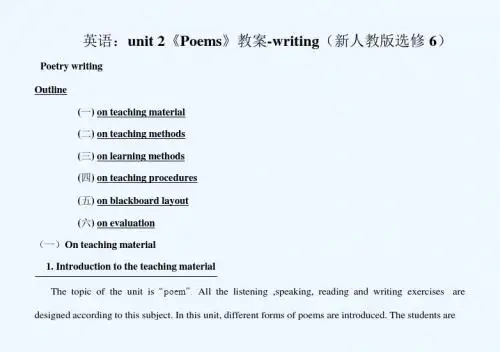
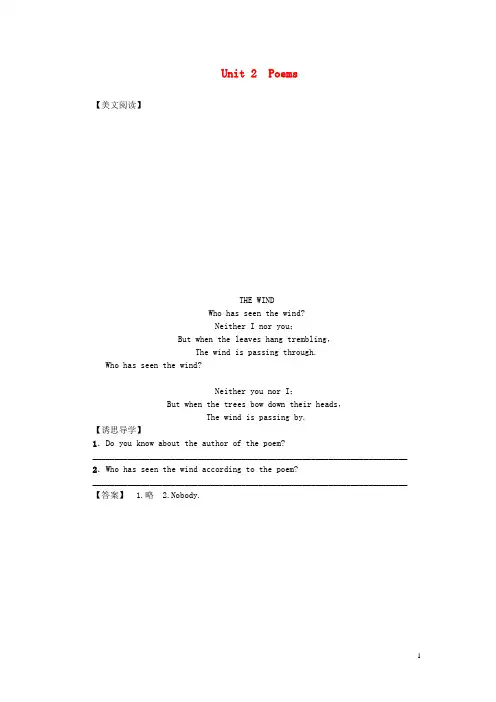
Unit 2 Poems【美文阅读】THE WINDWho has seen the wind?Neither I nor you;But when the leaves hang trembling,The wind is passing through.Who has seen the wind?Neither you nor I;But when the trees bow down their heads,The wind is passing by.【诱思导学】1.Do you know about the author of the poem?________________________________________________________________________ 2.Who has seen the wind according to the poem?________________________________________________________________________ 【答案】 1.略 2.Nobody.Period ⅠPreviewing●教学目标本课时主要是通过学生对学案所给出的内容的学习,了解本课文中所出现的词汇,初步了解课文以及相关的背景知识,对下一堂课课文的全面理解起到一个铺垫作用。
●教学地位本单元话题是“诗歌”。
文中涉及诗歌的韵律、节奏,并介绍了几种不同内容和形式的简单诗歌。
本单元引导学生讨论这些内容,目的在于让他们了解诗歌的一些基本特征和写作方法,自己尝试写简单的诗歌,并学会欣赏这些优美的文学作品。
●新课导入建议可以通过给学生看地图,拼地形图卡片,看幻灯片等,尽可能多的直观地向学生介绍有关英国概况的知识,使学生对当代英国的经济与政治,城市与乡村等诸多方面有一个整体认识。
老师要尽量给学生自主学习的时间和空间,通过自学、自做、自悟、自助等方式,让学生体会和理解文章的内容,探讨英国的文化。
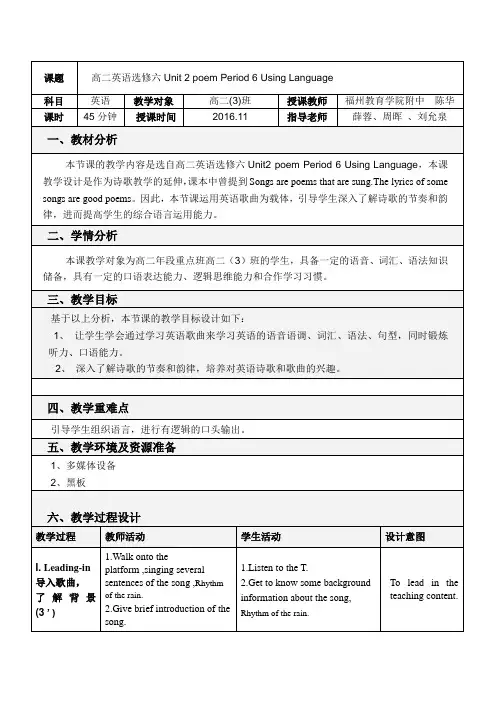
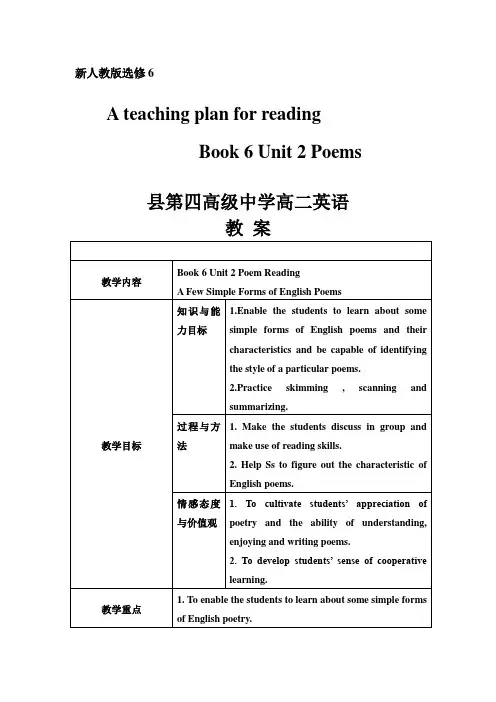
新人教版选修6A teaching plan for readingBook 6 Unit 2 Poems县第四高级中学高二英语教案教学内容Book 6 Unit 2 Poem ReadingA Few Simple Forms of English Poems教学目标知识与能力目标1.Enable the students to learn about somesimple forms of English poems and theircharacteristics and be capable of identifyingthe style of a particular poems.2.Practice skimming , scanning andsummarizing.过程与方法1. Make the students discuss in group andmake use of reading skills.2. Help Ss to figure out the characteristic ofEnglish poems.情感态度与价值观1. To cultivate students’ appreciation ofpoetry and the ability of understanding,enjoying and writing poems.2. To develop students’ sense of cooperativelearning.教学重点1. To enable the students to learn about some simple forms of English poetry.2. To improve the students’ ability of enjoying poems.教学难点To enable the students to write their own poems.教学方法与设备 A computer and a projector.教学过程StepⅠ. Warming up and pre-reading1.Play a song betrayal周传雄《黄昏》英文版 before class to motivate the interest. Ask students:"do you remember any poems in your childhood?"2. Show a video of an English song which is also a nursery rhyme before the class. Help them find out the rhyme and rhythm.《劳动号子》劳动号子嘛吼嘿,震天动地嘛吼嘿,Its rhyme is 嘛吼嘿盘古开天嘛吼嘿,唱到今天嘛吼嘿。
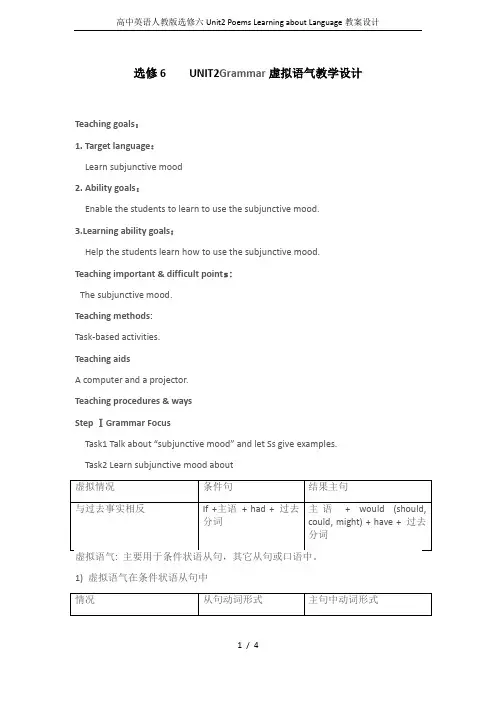
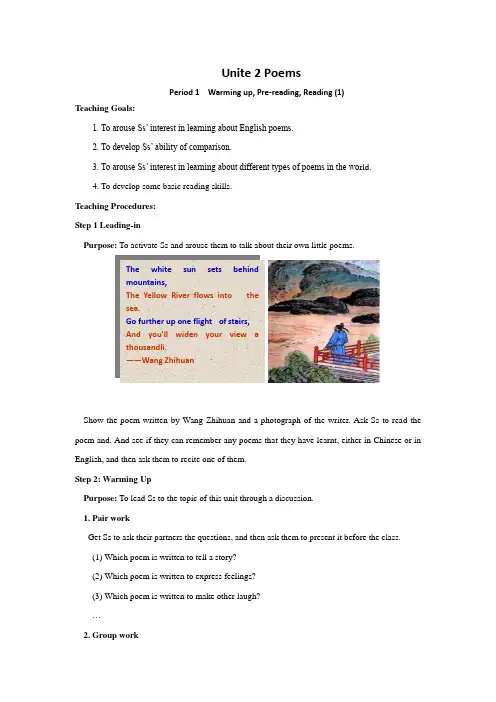
Unite 2 PoemsPeriod 1 Warming up, Pre-reading, Reading (1)Teaching Goals:1. To arouse Ss’ interest in learning about English poems.2. To develop Ss’ ability of comparison.3. To arouse Ss’ interest in learning about different types of poems in the wo rld.4. To develop some basic reading skills.Teaching Procedures:Step 1 Leading-inPurpose: To activate Ss and arouse them to talk about their own little poems.The white sun sets behindmountains,The Yellow River flows into thesea.Go further up one flight of stairs,And you'll widen your view athousandli.——Wang ZhihuanShow the poem written by Wang Zhihuan and a photograph of the writer. Ask Ss to read the poem and. And see if they can remember any poems that they have learnt, either in Chinese or in English, and then ask them to recite one of them.Step 2: Warming UpPurpose: To lead Ss to the topic of this unit through a discussion.1. Pair workGet Ss to ask their partners the questions, and then ask them to present it before the class.(1) Which poem is written to tell a story?(2) Which poem is written to express feelings?(3) Which poem is written to make other laugh?…2. Group workGet Ss to talk about the world famous poets. The pictures below can be used for Ss to talk about, and Ss can also talk as much as they can.William Shakespeare George Gordon Byron Li Bai威廉·莎士比亚乔治·戈登·拜伦李白(1) William Shakespeare: English playwright and poet whose body of works is consideredthe greatest in English literature. His plays, many of which wereperformed at the Globe Theatre in London, include historical works,such as Richard II, comedies, including Much Ado about Nothing andAs You Like It, and tragedies, such as Hamlet, Othello, and KingLear. He also composed 154 sonnets. The earliest collected edition ofhis plays, the First Folio, contained 36 plays and was publishedposthumously (1623).(2) George Gordon Byron: British poet acclaimed as one of the leading figures of theRomantic Movement. The Byronic hero lonely, rebellious, andbrooding first appeared in Manfred (1817). Among his other works areChilde Harold (1812-1818), The Prisoner of Chilton (1816), and theepic satire Don Juan (1819-1824). Byron was notorious for his loveaffairs and unconventional lifestyle. He died while working to secureGreek independence from the Turks.(3) Li Bai: Chinese poet who spent much of his time wandering and composingromantic, wine-inspired verse.Conclusion: All these poets are well known to the whole world and do you know any poems written by them? Can you recite to all the class?Step 3. Pre-readingPurpose: To help Ss learn about the context of the Reading part.1. Group workAsk Ss to discuss the questions with their partners in groups of four.(1) Do you have a favorite poem in Chinese?(2) Why is it your favorite poem?(3) Do you have a favorite poem in English?(4) Why is it your favorite poem?For example:(1) My favorite poem in Chinese is: 去年今日此门中,人面桃花相映红。

人教版高中英语选修6《Unit 2 Poem s》教案2篇Teaching plan of unit 2 Poems编订:JinTai College人教版高中英语选修6《Unit 2 Poems》教案2篇前言:英语作为在许多国际组织或者会议上都是必需语言,几乎所有学校选择英语作为其主要或唯一的外语必修课。
英语教学涉及多种专业理论知识,包括语言学、第二语言习得、词汇学、句法学、文体学、语料库理论、认知心理学等内容。
本教案根据英语课程标准的要求和教学对象的特点,将教学诸要素有序安排,确定合适的教学方案的设想和计划、并以启迪发展学生智力为根本目的。
便于学习和使用,本文档下载后内容可按需编辑修改及打印。
本文简要目录如下:【下载该文档后使用Word打开,按住键盘Ctrl键且鼠标单击目录内容即可跳转到对应篇章】1、篇章1:人教版高中英语选修6《Unit 2 Poems》教案2、篇章2:人教版高中英语选修6《Unit 2 Poems》教案篇章1:人教版高中英语选修6《Unit 2 Poems》教案教学准备教学目标教学目标(Teaching Aims)知识与技能(Knowledge and Skills)1.了解教学大纲关于语法填空的命题特点。
2.能够根据语法填空的命题特点自己编语法填空的题目3.掌握语法填空的解题方法与技巧过程与方法(Process and Methods)让每一位同学都能参与到课堂教学与活动中来,以小组或结对的形式进行相互学习和讨论。
情感态度与价值观(Feeling, Attitudes and Values)学习应对语法填空是与课文相结合,让学生在了解各种不同诗歌形式的背景下学习语法填空的设题与解题特点,从而更加理解英语诗歌的特色,更加懂得如何阅读和欣赏英语诗歌。
教学重难点教学重点(Important Points):1.让学生了解语法填空的命题特点2.掌握语法填空的解题方法与技巧教学难点(Difficult Points):语法填空中词性的转换教学过程(Teachers’ Activities)Step I: Lead-in① Review the new words and expressions of this unit by them together, and then do Task 1---speak out the other forms according to the giv en words② Listen to the song Jingle Bells and try tofill a word into each blank.Step II : Pre-practising1.Questions① Do you think it is difficult to complete the items of blank-filling with grammar knowledge?② Have you figur ed out the characteristics of the item?2.ExplainingIn this item there are 10 blanks for you to fill in with less than one proper word① some blanks with a given word while otherswith none② fill in the blanks with the proper form of the given word according to its grammatical and logical meaning.③ choose a preposition, pronoun, conjunction or an article to fill in the blank without any given word.3.DiscussionHow can we finish the items step by step with our grammar knowledge?① ___________________________________________.② _ __________________________________________.③ ___________________________________________.Step III : While-practising1.Making an item of grammatical blank-filling based on the para graph of the text.① more than 5 blanks.② some blanks with given word.③ others with none.2.exchange the item you made for your partner to complete it .3.The whole class finis h the one the teacher prepared for them.Step IV : Post-practising1.Check some of the students’ anwsers and give comments.2.Draw a conclusionStep V: Homework Assign ment1.Further improve your skills of dealing with the grammar filling.plete Ex.2 on Page 10, Nanfang New Class篇章2:人教版高中英语选修6《Unit 2 Poems》教案【按住Ctrl键点此返回目录】教学准备教学目标Teaching goals1.Target languagea. Important words and phrasesPoem, poetry, recite, aspect, convey, nursery, rhyme, diamond, cottage, balloon, sparrow, tease, salty, endless, translate, nursery rhyme, take it easy, run out of, make up ofb. Important sentencesWhich poem is about things that don’t make sense?Poets use many different forms of poems toexpress themselves.I hadn’t taken my eye off the ball.We hadn’t taken it easy.The poem is made up of five lines.A lot of Tang poetry has been translated into English. The translations have a free form that English people like to copy.2.Ability goalsa. Enable Ss to talk about different types of poems: nursery rhymes; list poems; cinquain,; haiku; Tang poemsb. Enable Ss to talk about different purposes of writing poems.c. Understand the main theme of each poem.d. Enable Ss to chant some of their favorite poems.3.Learning abilityEnable Ss to distinguish different types of poems 教学重难点Teaching important points1.Talk about five main types of poems.2.Understand the main purpose of writing the poems.Teaching difficult points1.Find the rhythm of each poem.2.Chant the poem.3.Understand the main purpose of writing the poems.教学过程Teaching procedures to share a feeling or experience; to describe something in detail or give an impression; to get the reader to think about an idea; to express a point of view; to make the reader experience the sight, sounds, smells, feel and tastes of something; to create a mood, to play with words--- their sounds, rhyme and rhythm.)If time permits, in small groups or as a class, discuss the kinds of topics that poets write about.( people, animals, nature, landscapes, the sea, the seasons, stories, death, war, youth and old age,feeling and experiences, emotions like love, hate, sadness, regret and desire, etc.)Step 4.Pre-readingPeople from different countries write different kinds of poems. Get Ss to discuss the questions on Page 9 with their partners: Do you have a favorite poem in Chinese? Why ? Do you have a favorite poem in English? Why?As to exercise 2, give Ss practice in animportant reading skill: scanning a text, that is, looking through a text quickly to find specific information. Read the table in exercise 2 with the Ss. Tell them that they are going to look for the information in the table, just in the poems themselves, not in the other parts of the text. They are to look only for those pieces of information and not readevery word. Do an example with them.Suggested answers to exercise 2:Step 5.ReadingScanningGet the Ss to read the passage quickly and accurately and meanwhile help the Ss to form a good habit of reading. Teacher gives Ss a couple of minutes to look through the whole passage. Tell them to read the text silently and then ask some detailed questions about the text on the slide show . Teacher should encourage Ss to express their ideas.Q1.Why do people write poetry?Q2.How many forms of poems are mentioned in the passage? What are they?Q3.What does “nursery rhyme” mean? Why do they delight small children?Q4.What’s the characteristic of “list poems”? What about “cinquain”?Q5.Why do English People like “Haiku”?Q6.Are you familiar with Tang Poems? Do you know the title of the last poem in the text?ListeningBefore Ss read the text, have them close their books and listen to the text with their eyes closed. This gives Ss the opportunity to listen to the sounds or “music” of the poems before reading them in detail. Tell them that it doesn’t ma tter if they don’t understand every word.First readingGet Ss to read the text carefully, finding the one sentence that sums up the paragraph of each part.. Underline the topic sentence.Second readingTell Ss that they are going to look at the rhythm of two of the poems. Make sure they know what rhythm is. Read the limerick aloud and have Ss listen for the strong beats. Then have them clap the strong beats asyou read. Mark the strong beats on the limerick on the board.There was an old man with a beardWho said “it is just as I feared”.“Four insects and thenTwo birds and a henHave all made a home in my beard”.Now read the poem A & B. Ask them to mark the strong beats on the two poems that have a strong rhythm. Check their answers . Then play the tape and get them to clap to the strong beats in those two poems.Third readingJust as any scene can serve as the subject of a painting, so any part of daily life can provide material for a poem.. Of course, the choice that the artist or poet makes relates to his or her purpose. Poetry is usually short and compact, so it should beread several times, preferably aloud, to appreciateits meaning. Read the last poem (Poem H), and answer the following questions:Q1.What parts of the poem suggest that the woman loves her husband?Q2.How do you understand the sentence” Shouldthe journeyer return, this stone would utter speech.”? Explain the sentence in your own words.Q3.What picture do you have in your mind when you read the above sentences?Q4.Do you know the Chinese title of this poem? Do you know the Chinese version of the poem?Step 6.Make a short summary of this period.课后习题Homework1.Surf some websites to find out more information about poets.2.Review the content of the reading passage.3.Finish the exercises on Page 12& 13.-------- Designed By JinTai College ---------。
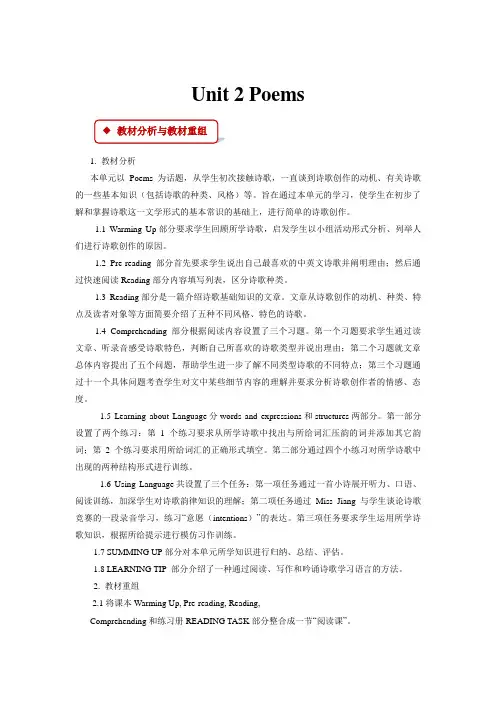
Unit 2 Poems1. 教材分析本单元以Poems为话题,从学生初次接触诗歌,一直谈到诗歌创作的动机、有关诗歌的一些基本知识(包括诗歌的种类、风格)等。
旨在通过本单元的学习,使学生在初步了解和掌握诗歌这一文学形式的基本常识的基础上,进行简单的诗歌创作。
1.1 Warming Up部分要求学生回顾所学诗歌,启发学生以小组活动形式分析、列举人们进行诗歌创作的原因。
1.2 Pre-reading 部分首先要求学生说出自己最喜欢的中英文诗歌并阐明理由;然后通过快速阅读Reading部分内容填写列表,区分诗歌种类。
1.3 Reading部分是一篇介绍诗歌基础知识的文章。
文章从诗歌创作的动机、种类、特点及读者对象等方面简要介绍了五种不同风格、特色的诗歌。
1.4 Comprehending 部分根据阅读内容设置了三个习题。
第一个习题要求学生通过读文章、听录音感受诗歌特色,判断自己所喜欢的诗歌类型并说出理由;第二个习题就文章总体内容提出了五个问题,帮助学生进一步了解不同类型诗歌的不同特点;第三个习题通过十一个具体问题考查学生对文中某些细节内容的理解并要求分析诗歌创作者的情感、态度。
1.5 Learning about Language分words and expressions和structures两部分。
第一部分设置了两个练习:第1个练习要求从所学诗歌中找出与所给词汇压韵的词并添加其它韵词;第2个练习要求用所给词汇的正确形式填空。
第二部分通过四个小练习对所学诗歌中出现的两种结构形式进行训练。
1.6 Using Language共设置了三个任务:第一项任务通过一首小诗展开听力、口语、阅读训练,加深学生对诗歌韵律知识的理解;第二项任务通过Miss Jiang与学生谈论诗歌竞赛的一段录音学习,练习“意愿(intentions)”的表达。
第三项任务要求学生运用所学诗歌知识,根据所给提示进行模仿习作训练。
1.7 SUMMING UP部分对本单元所学知识进行归纳、总结、评估。
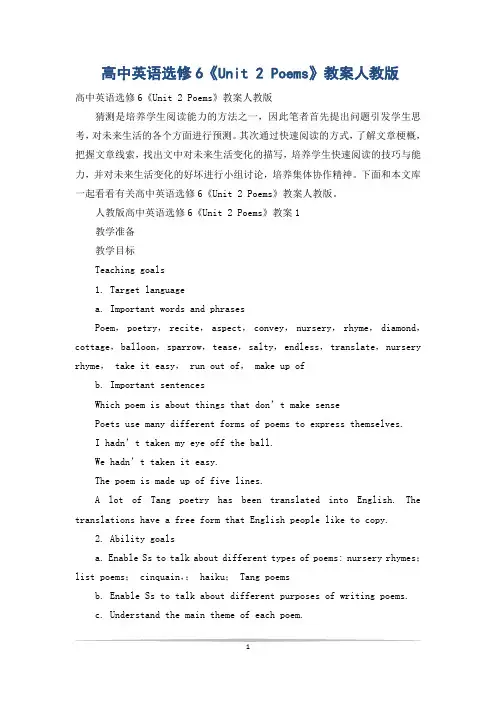
高中英语选修6《Unit 2 Poems》教案人教版高中英语选修6《Unit 2 Poems》教案人教版猜测是培养学生阅读能力的方法之一,因此笔者首先提出问题引发学生思考,对未来生活的各个方面进行预测。
其次通过快速阅读的方式,了解文章梗概,把握文章线索,找出文中对未来生活变化的描写,培养学生快速阅读的技巧与能力,并对未来生活变化的好坏进行小组讨论,培养集体协作精神。
下面和本文库一起看看有关高中英语选修6《Unit 2 Poems》教案人教版。
人教版高中英语选修6《Unit 2 Poems》教案1教学准备教学目标Teaching goals1. Target languagea. Important words and phrasesPoem, poetry, recite, aspect, convey, nursery, rhyme, diamond,cottage, balloon, sparrow, tease, salty, endless, translate, nursery rhyme, take it easy, run out of, make up ofb. Important sentencesWhich poem is about things that don’t make sensePoets use many different forms of poems to express themselves.I hadn’t taken my eye off the ball.We hadn’t taken it easy.The poem is made up of five lines.A lot of Tang poetry has been translated into English. The translations have a free form that English people like to copy.2. Ability goalsa. Enable Ss to talk about different types of poems: nursery rhymes;list poems; cinquain,; haiku; Tang poemsb. Enable Ss to talk about different purposes of writing poems.c. Understand the main theme of each poem.d. Enable Ss to chant some of their favorite poems.3. Learning abilityEnable Ss to distinguish different types of poems教学重难点Teaching important points1. Talk about five main types of poems.2. Understand the main purpose of writing the poems.Teaching difficult points1. Find the rhythm of each poem.2. Chant the poem.3. Understand the main purpose of writing the poems.教学过程Teaching procedures … waysStep 1. GreetingsStep 2. PresentationAsk Ss to think back and try to remember poems from their early childhood, either in Chinese or in English.Talk about some famous poets both home and abroad, either ancient ones or modern ones.Brainstorming: What will you think of when we talk about the word "poem"Step 3. Warming upRead the questions in this part, reminding Ss what they notice about the above poems.(e.g. they have a strong beat, or they have rhyme, or they play with words and sounds, or perhaps some of them are funny because they make no sense.)Tell Ss that there are many reasons why people write poetry. Give the examples on the Bb. Ask Ss why they think the poets wrote the poems they have just recited.. Write their suggestions on the board.Give Ss a time limit of a few minutes. Divide the class into groups of four to discuss the purpose of writing poems. Ask one person from each group to read their group’s list and add their suggestions to the list on the board. (Suggested reasons: to create certain feelings or images in the reader; to share a feeling or experience; to describe something in detail or give an impression; to get the reader to think about an idea;to express a point of view; to make the reader experience the sight,sounds, smells, feel and tastes of something; to create a mood, to play with words--- their sounds, rhyme and rhythm.)If time permits, in small groups or as a class, discuss the kinds of topics that poets write about.( people, animals, nature, landscapes,the sea, the seasons, stories, death, war, youth and old age, feeling and experiences, emotions like love, hate, sadness, regret and desire,etc.)Step 4. Pre-readingPeople from different countries write different kinds of poems. Get Ss to discuss the questions on Page 9 with their partners: Do you have a favorite poem in Chinese Why Do you have a favorite poem in English WhyAs to exercise 2, give Ss practice in an important reading skill: scanning a text, that is, looking through a text quickly to find specific information. Read the table in exercise 2 with the Ss. Tell them that they are going to look for the information in the table, just in the poems themselves, not in the other parts of the text. They are to look only for those pieces of information and not read every word. Do an example with them.Suggested answers to exercise 2:Step 5. ReadingScanningGet the Ss to read the passage quickly and accurately and meanwhile help the Ss to form a good habit of reading. Teacher gives Ss a couple of minutes to look through the whole passage. Tell them to read the text silently and then ask some detailed questions about the text on the slide show . Teacher should encourage Ss to express their ideas.Q1. Why do people write poetryQ2. How many forms of poems are mentioned in the passage What are they Q3. What does "nursery rhyme"mean Why do they delight small childrenQ4. What’s the characteristic of "list poems"What about "cinquain"Q5. Why do English People like "Haiku"Q6. Are you familiar with Tang Poems Do you know the title of the last poem in the textListeningBefore Ss read the text, have them close their books and listen to the text with their eyes closed. This gives Ss the opportunity to listen to the sounds or "music" of the poems before reading them in detail. Tell them that it doesn’t matter if they don’t understand every word. First readingGet Ss to read the text carefully, finding the one sentence that sums up the paragraph of each part.. Underline the topic sentence.Second readingTell Ss that they are going to look at the rhythm of two of the poems. Make sure they know what rhythm is. Read the limerick aloud and have Ss listen for the strong beats. Then have them clap the strong beats as you read. Mark the strong beats on the limerick on the board.There was an old man with a beardWho said "it is just as I feared"."Four insects and thenTwo birds and a henHave all made a home in my beard".Now read the poem A … B. Ask them to mark the strong beats on the two poems that have a strong rhythm. Check their answers . Then play the tape and get them to clap to the strong beats in those two poems.Third readingJust as any scene can serve as the subject of a painting, so any part of daily life can provide material for a poem.. Of course, the choice that the artist or poet makes relates to his or her purpose. Poetry is usually short and compact, so it should be read several times, preferably aloud, to appreciate its meaning. Read the last poem (Poem H), and answer the following questions:Q1. What parts of the poem suggest that the woman loves her husband Q2. How do you understand the sentence" Should the journeyer return,this stone would utter speech." Explain the sentence in your own words. Q3. What picture do you have in your mind when you read the above sentencesQ4. Do you know the Chinese title of this poem Do you know the Chinese version of the poemStep 6. Make a short summary of this period.课后习题Homework1. Surf some websites to find out more information about poets.2. Review the content of the reading passage.3. Finish the exercises on Page 12… 13.人教版高中英语选修6《Unit 2 Poems》教案2教学准备教学目标教学目标(Teaching Aims)知识与技能(Knowledge and Skills)1. 了解教学大纲关于语法填空的命题特点。
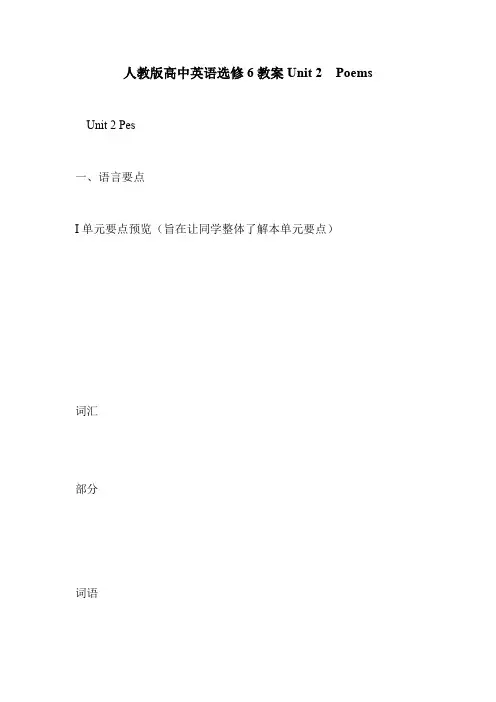
人教版高中英语选修6教案Unit 2 Poems Unit 2 Pes一、语言要点I单元要点预览(旨在让同学整体了解本单元要点)词汇部分词语辨析1pe/petr 2transfr/hange 3apprpriate/suitable/fit 4 run ut/run ut f词形变化1 srr n 悲哀, 悲痛srrful ad 悲伤的2 anger n 怒, 愤怒angr ad 生气的, 愤怒的angril adv 愤怒地3 translate v 翻译, 转变为translatin n 翻译, 译translatr n 翻译者4 ending n 结尾, 结局end v 结束, 终结,end n末端, 尽头重点单词1 aspet n方面;样子;外表2 nve v传达;运送3 nrete ad具体的4 tease v取笑;招惹;戏弄pattern n模式;式样;图案6 underline v在下面画线;强调7 exhange v交换,交流8 spnsr n赞助人;主办者vt发起,举办,倡议重点词组tae it eas从容, 不紧张, 松懈, 轻松ae up f(多用于被动)构成tr ut 试验, 考验, let ut发出, 泄露重点句子1Se pes tell a str r desribe sething in a a that ill give the reader a strng ipressin thers tr t nve ertain etins2 And said thugh strange the all ere true重点语法虚拟语气(II)(见语法专题)II 词语辨析(旨在提供完形填空所需材料)1) pe/petr n 诗歌【解释】pe[]诗歌,诗体petr[U]诗歌的总称【练习】选择pe或petr并用其适当的形式填空1) eats and Shaespeare are asters f English ______2) Peple rite _________ t ae ther laughes: 1) petr 2) pes2) transfr/hange v改变,变化【解释】transfr指“人、物在性质上或形态上发生彻底或基本的变化”hange指“使改变得与原物不同”或“使发生以新代旧的变化”【练习】选择transfr或hange,并用其适当的形式填空1) Heat an __________ ater int stea2) The appearane f the tn is quite ________es: 1) transfr 2) hanged3) apprpriate/suitable/fit ad合适的,适当的【解释】apprpriate 形容事物在特定的时间合适,或与特定场合协调一致。
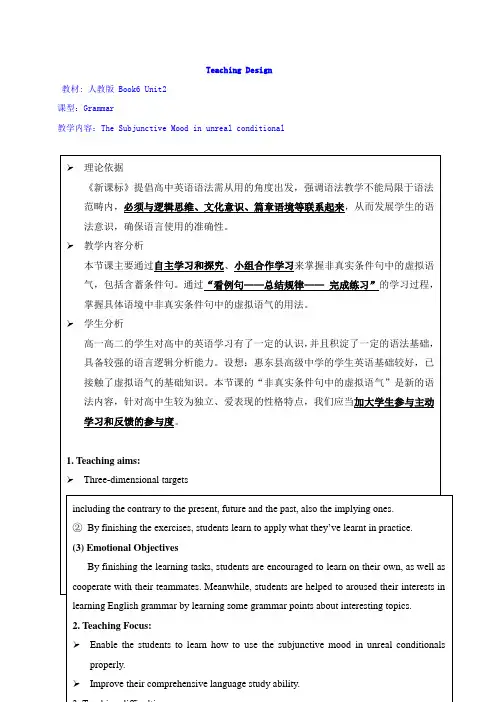
Teaching Design教材: 人教版 Book6 Unit2课型:Grammar教学内容:The Subjunctive Mood in unreal conditional◆◆◆◆品味人生1、不管鸟的翅膀多么完美,如果不凭借空气,鸟就永远飞不到高空。
想象力是翅膀,客观实际是空气,只有两方面紧密结合,才能取得显着成绩。
2、想停下来深情地沉湎一番,怎奈行驶的船却没有铁锚;想回过头去重温旧梦,怎奈身后早已没有了归途。
因为时间的钟摆一刻也不曾停顿过,所以生命便赋予我们将在汹涌的大潮之中不停地颠簸。
3、真正痛苦的人,却在笑脸的背后,流着别人无法知道的眼泪,生活中我们笑得比谁都开心,可是当所有的人潮散去的时候,我们比谁都落寂。
4、温暖是飘飘洒洒的春雨;温暖是写在脸上的笑影;温暖是义无反顾的响应;温暖是一丝不苟的配合。
5、幸福,是一种人生的感悟,一种个人的体验。
也许,幸福是你风尘仆仆走进家门时亲切的笑脸;也许,幸福是你卧病床上百无聊赖时温馨的问候;也许,幸福是你屡遭挫折心灰意冷时劝慰的话语;也许,幸福是你历经艰辛获得成功时赞赏的掌声。
关键的是,你要有一副热爱生活的心肠,要有一个积极奋进的目标,要有一种矢志不渝的追求。
这样,你才能感受到幸福。
6、母爱是迷惘时苦口婆心的规劝;母爱是远行时一声殷切的叮咛;母爱是孤苦无助时慈祥的微笑。
7、淡淡素笺,浓浓墨韵,典雅的文字,浸染尘世情怀;悠悠岁月,袅袅茶香,别致的杯盏,盛满诗样芳华;云淡风轻,捧茗品文,灵动的音符,吟唱温馨暖语;春花秋月,红尘阡陌,放飞的思绪,漫过四季如歌。
读一段美文,品一盏香茗,听一曲琴音,拾一抹心情。
8、尘缘飞花,人去楼空,梦里花落为谁痛?顾眸流盼,几许痴缠。
把自己揉入了轮回里,忆起,在曾相逢的梦里;别离,在泪眼迷朦的花落间;心碎,在指尖的苍白中;淡落,在亘古的残梦中。
在夜莺凄凉的叹息里,让片片细腻的柔情,哽咽失语在暗夜的诗句里。
9、用不朽的“人”字支撑起来的美好风景,既有“虽体解吾犹未变兮”的执着吟哦,也有“我辈岂是蓬蒿人”的跌宕胸怀;既有“我以我血荐轩辕”的崇高追求,也有“敢教日月换新天”的豪放气魄。
教案1 Unit2 PoemsReadingTeaching material: NSEFC Book 6 —— Unit 2Teaching AimsTo cultivate students’ interest of poetry and improve their reading skills.Teaching Important & Difficult PointsHow to help the students to grasp and remember the detailed information of the reading material. Teaching aids:a tape recorder, a projector, Slides and PicturesTeaching ProcedureStep 1 Warming up1. Which poems and poets can you think of when seeing the following pictures?静夜思李白床前明月光,疑是地上霜。
举头望明月,低头思故乡。
古风其二李绅锄禾日当午,汗滴和下土。
谁知盘中餐,粒粒皆辛苦。
望夫石王健望夫处,江悠悠。
化为石,不回头。
山头日日风复雨,行人归来石应语。
2. Match the following information.Li Bai Song DynastyDu Fu Tang DynastyFan Zhongyan Tang DynastyMeng Haoran ModernGuo Moruo ModernMao Zedong Tang DynastyByron AmericaShelly EnglandEmerson EnglandTagore GermanyGoethe IndiaStep 2 BrainstormingDiscuss the reasons why people write poems.Fast readingScan the passage and answer the following questions.1. What is the main topic of the reading passage?2. What five kinds of poems does the reading passage talk about?different forms of English poemsnursery rhymes, list poems, cinquain, haiku, Tang poems.3. Scan the poems and fill in the following form.Which poem A B C D E F G H describes a person?tells a story?describes an aspect of aperson?is about sport?is about things that don’tmake sense?is recited to a baby?describes a river scene?has rhyming words at theend of lines?repeats words andphrases?Step 3 Careful readingT: Now let’s read the following five poems and finish tasks.Slide showListen to Poem A and pay attention to its rhyming lines and words.Hush, little baby, don’t say a w ord,Papa’s going to buy you a mockingb ird.If that mockingbird won’t s ing,Papa’s going to buy you a diamond r ing.If that diamond ring turns to br ass,Papa’s going to buy you a looking gl ass.If that looking-glass gets br o ke,Papa’s going to buy you a billy-g oa t.If that billy-goat runs aw ay,Papa is going to buy you another d ay.Read the poem by yourself again and answer the following questions.1. What’s the baby’s father going to buy if the lookin g-glass gets broken?2. What is Papa going to buy for the baby if that billy-goat runs away?3. What are the features of it?Keys:1. a billy -goat2. another billy-goat3. It has strong rhythm and rhyme and has a lot of repetition.Poem COur first football matchWe would have won…If Jack had just scored that goal,If we’d had just a few more minutes,If we had trained harder,If Ben had passed the ball to Joe,If we’d had thousands of fans screaming,If I hadn’t taken my eye off the ball,If we ha dn’t stayed up so late the night before,If we hadn’t taken it easy,If we hadn’t run out of energy,We would have won…If we’ve been better!Questions1. Did his or her team win the game?2. Why his or her team didn’t win the game?3. Does the speaker really believe his or her own excuse? How do you know?Keys:1. No, his or her team didn’t win.2. The players didn’t win because: Jack didn’t score that goal; they didn’t have enough time; they hadn’t trained hard….3. The speaker doesn’t really believe his or her own excuses, because there has too many ifs…Poem D&E1. What subject is the speaker writing about?2. Does the speaker like the subject? Give a reason for your answer.T: We have enjoyed so many English poems. Some are traditional forms of English poetry but some are not, for example haiku. (It comes from Japanese).In fact English speaker also have borrowed from another kind of Asian poetry---Tang poems from China.Poem H at the bottom of this passage is a translation from the Chinese. Poem HWhere she awaits her husband,On and on the river flowsNever looking back,Transformed into stone.Day by day upon the mountain top,wind and rain revolve.Should the journey return,this stone would utter speech.(By Wang Jian)望夫石王健望夫处,江悠悠。
Unit 2 Poem GrammarSubjunctive Mood一、设计思想1、指导思想本节课主要以教学大纲,考试说明为依据,以课程标准为准绳,充分发挥教师主导作用,学生主体作用。
努力将新课程的理念融入教学之中,以学生为主体,设计了“观察-对比/讨论-归纳-巩固-运用”一系列环节,让学生通过观察法、自主探究、实践体验来掌握虚拟语气在if条件句中的基本用法和高考中此类题目的解题方法。
努力发挥过程性评价和形成性评价的激励功能,主要利用学生合作学习来激发学生参与教学的热情、发现问题和解决问题的能力。
2、教学目标(1)知识与能力:通过本节课的学习,大部分学生能够在掌握高考英语中if引导的非真实条件句的考点和考向的基础上,运用if引导的非真实条件句来进行自我表达和正确解决高考中出现的此类试题。
(2)方法与途径:通过设计“观察-对比/讨论-归纳-巩固-运用”一系列环节,让学生通过积极参与来体验自主探究的过程,培养学生自主学习和合作学习的能力。
(3)情感与评价:通过一系列任务的完成,激发学生学习英语的热情,培养学生小组合作意识,提高互助学习,互相帮助的意识。
将过程性评价和形成性评价有效的结合起来,发挥其激励功能。
(4)现代教学手段:多媒体课件和导学案3、教学重点与难点(1)教学重点:高中英语语法教学中,虚拟语气作为高考常考的语法项目之一,主要考查if引导的非真实条件句。
同时,if既可引导真实条件句,又可引导非真实条件句,学生容易混淆该语法知识。
因此,本节课的教学重点是引导学生学习和掌握if引导的非真实条件句的基本结构和用法。
(2)教学难点:使学生能够充分地掌握if引导的非真实条件句的考点考向,并能运用if引导的非真实条件句来进行自我表达和正确解决高考中出现的此类试题。
二、教学准备本节课的教学目标是帮助学生掌握if引导的非真实条件句的基本结构和用法,提高学生的英语知识综合运用能力。
在进行教学设计时,我首先学习了《2015年普通高等学校招生全国统一考试大纲的说明》、《普通高等学校招生全国统一考试》陕西卷英语考试说明,以及新课标对于该语法知识的要求,以使自己在正确理念和要求的指导下进行备课。
Teaching topic: New Senior English for ChinaStudent’s Book 6Unit 2 PoemsTeaching type: Using language一、教学背景分析:本单元的中心话题是诗歌,本单元的教学目的是向学生介绍几种简单的不同内容和形式的诗歌,让他们了解诗歌的一些基本特征和写作方法。
本单元是以欣赏为主,希望把诗歌引入课堂,把对美的感悟带进学生心灵,把对英语文学的热爱传递给学生。
本课题在教材中的地位与作用:本课为Unit 2 Poems的第五课时“Using Language”。
本课的主要目的在于使学生进一步感受诗歌的语言美,节奏美,希望学生们能够写出一首清单诗,并且能够从诗歌的美中感受到英语文学的美,感受到生活的美。
二、教学目标分析确立教学目标的依据:本节课授课学生英语基础比较好,通过Warming up和Reading的学习对几种简单的诗歌类型以及特点已经有了一定的掌握和理解,他们可以通过朗诵,表演来品味英语诗歌和谐、优美、富于音乐感的韵味。
因此我制定了这样的教学目标:Knowledge aim:●Enjoy an English poem and have a basic knowledge of poetry, such as rhythm and rhyme.欣赏诗歌并且了解诗歌的基本常识,韵脚及押韵等。
●学会使用If 虚拟语气。
Ability aims:●Improve the ability of appreciating a poem.提高欣赏诗歌的能力。
●Write a list poem using what they have learned in this class.用课堂所学写一首清单诗。
Moral aims:●Arouse the students’ interest in poetry.激发学生对诗歌的兴趣。
某某省某某一中高二英语选修6 Unit 2 Poems 教案一、词汇预习:1. poet 诗人n. —— poem 诗n. —— poetry 诗歌(总称)n.[U]2. rhyme(押)韵 n./v.--rhythm节奏,韵律n.--- rhythmic有节奏的adj.3. emotion 情绪,情感n.------- emotional 情绪的;易激动的adj.4. repeat 重复;复述v.------- repetition重复n. ----- repeated重复的,反复的adj.5. salt 盐n.---- salty含盐的,咸的adj.6. dread害怕,畏惧v.---dreadful可怕的 adj.7. end 结束v./n.---- endless无穷的,无止境的 adj.8. minimum最低限度;最少量;最小数;n.--- maximum最大限度;最大值 n.9. translate翻译 v.--- translation翻译;译文n. ---- translator翻译人;译者 n.10. library 图书馆 n.--- librarian 图书管理员;图书馆馆长 n.11. (n.) 指南针--- passes (pl.)圆规12. bride新娘 --- bridegroom新郎13. champion 冠军n.--- championship冠军称号n.14. dark ---- darkness 黑暗n. in the dark 在黑暗中15. warm 暖和,温暖adj.--- warmth 暖和,温暖n.--- warmly热烈地;亲切地adv.16. school --- scholar学者n. --- scholarship奖学金;学问;学术成就n.17. piano --- pianist18. violin --- violist19. transform 改变,转变v.--- transformation改变,转变n.20. sorrow 悲伤,悲痛;懊悔n.--- sorrowful悲伤的,悲痛的adj.21. eventually 最后;终于 adv.--- eventual 最后;终于 adj.22. load 装载;负荷;工作量n./v.--- unload卸下v. --- download下载v.--- upload 上传v.二、精讲词汇(必须掌握的词)1. conveyconvey sthto sb.①Colors like red convey a sense of energy and strength.红色之类的颜色可给人以充满活力与力量的感觉。
Unit 2 Poems教学目标1.知识技能目标:掌握阅读的基本技巧,快速找出主题句。
2语言能力目标:学会鉴赏不同类型的英文诗歌,并进行简单的创作。
3.情感态度目标:培养学生欣赏英文诗歌,了解中英文诗歌的不通和中西方文化的差异;培养学生的合作精神和协作能力。
教学重点1.学会鉴赏英文诗歌,了解其表达的情感。
2.掌握几种不同诗歌的特点。
学时难点1.快速找出每段的中心句,掌握大意。
教学活动【导入】warming up1. students appreciate a chinese poem and listen to the song.2.guess the two English poems.(设计思路)通过熟悉的中文诗导入到大家非常熟悉的外国诗歌的名句,激发了学生继续探索的热情,引入到了本节课的主题。
【讲授】reading1.Fast reading.How many kinds of poems are mentioned in the text? what are they?(设计思路)让学生通过小标题迅速捕捉题目意图,找到这五种诗歌:分别是:nursery rhyme, list poems, sinquain, haiku, and tang poems.2.Careful reading.Find out the characteristics of each poem.(1)Nursery rhymes(A)Now listen to poem A carefully and find out the rhyming words. word-mockingbird sing-ring brass-Looking-glass broke- billy-goat away-today特点:The language is concrete but imaginative. They rhyme, have strong rhythm and a lot of repetition, easy to learn and recite.(设计思路) 听童谣,找出押韵的词,同时训练了学生的听力技巧(2)List poems (B and C)They have a flexible line length and repeated phrases. Some rhyme while others do not.(设计思路)诗歌B基本上逗乐没有什么实际意义,诗歌C运用了虚拟语气(3)Cinquain (D and E)Made up of five lines, convey a strong picture in just a few words. Students group work, analyse the characteristics.Line1: a noun that names the subject of the poem.Line2: two adjectives that describe the subject.Line3:three verbs ending with-ing that describe the subject's action. Line4, four words that give the writer's opinion of feeling about the subject.Line5: a word that gives another name for the subject.(设计思路):学生分组讨论,总结和分析五行诗的特点,培养学生的合作协同能力,让更多的学生参与到课堂活动中来。
高中英语选修六第二单元《Poems》参赛教案人教版高中英语选修六第二单元《Poems》教案设计作者姓名:王慧铭学校名称:平川中恒学校人教版高中英语选修六第二单元《Poems》教案设计想学好英语,首先要培养对英语的兴趣。
“兴趣是最好的老师”,兴趣是学习英语的巨大动力,有了兴趣,学习就会事半功倍。
我们都有这样的经验:喜欢的事,就容易坚持下去;不喜欢的事,是很难坚持下去的。
而兴趣不是与生俱来的,需要培养。
有的同学说:“我一看到英语就头疼,怎么能培养对英语的兴趣呢?”还有的同学说:“英语单词我今天记了明天忘,我太笨了,唉,我算没治了。
”这都是缺乏信心的表现。
初学英语时,没有掌握正确的学习方法,没有树立必胜的信心,缺乏了克服困难的勇气,丧失了上进的动力,稍遇失败,就会向挫折缴枪,向困难低头。
你就会感到英语是一门枯燥无味的学科,学了一段时间之后,学习积极性也逐渐降低,自然也就不会取得好成绩。
但是,只要在老师的帮助下,认识到学英语的必要性,用正确的态度对待英语学习,用科学的方法指导学习。
开始时多参加一些英语方面的活动,比如,唱英文歌、做英语游戏、读英语幽默短文、练习口头对话等。
时间长了,懂得多了,就有了兴趣,当然,学习起来就有了动力和欲望。
然后,就要像农民一样勤勤恳恳,不辞辛苦,付出辛勤的劳动和汗水,一定会取得成功,收获丰硕的成果。
毕竟是No pains, no gains吗。
练好基本功是学好英语的必要条件,没有扎实的英语基础,就谈不上继续学习,更谈不上有所成就。
要想基本功扎实,必须全神贯注地认真听讲,上好每一节课,提高课堂效率,脚踏实地、一步一个脚印地,做到以下“五到”:一、“心到”。
在课堂上应聚精会神,一刻也不能懈怠,大脑要始终处于积极状态,思维要活跃、思路要开阔,心随老师走,听懂每一句话,抓住每一个环节,理解每一个知识点,多联想、多思考,做到心领神会。
二、“手到”。
学英语,一定要做课堂笔记。
因为人的记忆力是有限的,人不可能都过目不忘,记忆本身就是不断与遗忘作斗争的过程。